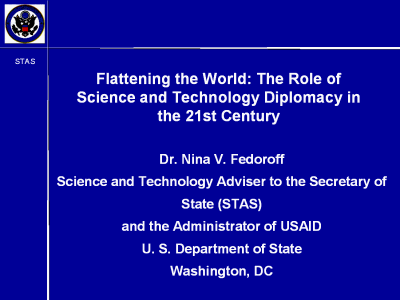 |
In sum: there is much work – both
scientific and diplomatic – to be done. I hope I have succeeded in giving
you a small glimpse of the opportunities available to scientists to serve be
science diplomats, both in and out of the State Department. I am optimistic
that in the coming years, we will build further bridges directly between
academics in developed and developing countries.
To that end, Secretary
of State Condoleeza Rice and Secretary of Education Margaret Spellings,
together with USAID Administrator Henrietta Fore, are convening a global
University Presidents’ Summit on the 29th
and 30th
of April this year to explore innovative ways of connecting the educational
institutions of more and less developed countries, with the objective of
improving education and research, as well as stimulating innovative
approaches to knowledge-driven economic development in the less-developed
countries.
The G8 countries have promised billions
of dollars to rebuild African universities and establish research centers of
excellence, although only a tiny fraction of it has materialized so far.
David Skorton, President of Cornell University, has suggested that we need a
plan on the scale of the Marshall plan enacted after the WWII, but focused
on university capacity building in less developed countries, particularly in
Africa and the Middle East. We need all of that – and much more.
I have not spoken here of the need to
increase soil productivity, improve access to primary and secondary
education, and health care, as well as improve transportation and
telecommunications infrastructure – all of these are pressing needs and
there is an increasing awareness that they must be tackled simultaneously,
as, for example, the Millenium Villages Project seeks to do.
My focus here has been on what science
and scientists can do. And even here, I think it will be necessary for
universities and research centers in the developed world to go far beyond
just helping the universities of the less developed world to deliver
education. It will be equally necessary to help them embark on the difficult
process of converting research findings into economic drivers, into
businesses.
I think that our research universities
and institutes, working together with the business sector and using
contemporary electronic resources, have a unique opportunity to accelerate
the “flattening” of the world, to call on Tom Friedman’s metaphor once
again. Can it be done? Yes. For example, Cisco Systems has started literally
thousands of Cisco Academies, training centers for IT support specialists,
around the world. Art Reilly, a Cisco Systems Senior Director, told me
recently that a startling 12% of Cisco Academy graduates in the developing
world start their own businesses. Now while network support is good,
knowledge generation is limitless.
There is little doubt that American
universities are eager to go global. But, according to a recent New York
Times article, the most visible and successful outposts have been created in
response to invitations from wealthy countries, particular those of the
United Arab Emirates, and appear to have the primary objectives of widening
the home institution’s income pool and its foreign student base (“U. S.
Universities Rush to Set Up Outposts Abroad,” NYT 10 Feb. 2008).
The task of assisting much less-wealthy
countries to bolster the instructional, organizational, research and
technology transfer capabilities of their own institutions is a vastly
different proposition. Most academic scientists look to foreign institutions
for top-notch graduate students and post-docs to populate their
laboratories. The notion of taking time out from a busy and competitive
career to teach and develop research collaborations in the least advanced
countries most in need of help is just not on the academic radar screen.
And yet science is our
best global common language, able to bridge the deepest of political and
religiousdivides. (It’ll get us across the digital divide, as well, no
doubt.) There is a growing recognition in every country that it is science
and technology that drive – and will increasingly drive – the successful
economies of the 21st
century. Our scientists and engineers are still welcome. Input of US science
and technology is sought by developing countries on issues ranging from the
solution of acute problems of food, water, and health to the longer-term
problems of higher education, environment, global climate disruption, and
economic development through innovation.
Perhaps we need to recognize, concretely
within the reward structure of the academic world, that scientists and
engineers have not just a critical, but a crucial, role to play in creating
a future in which the citizens of all countries have the educational and
economic opportunities that we have. Only when we have equalized food
productivity, access to health care, educational opportunities, and economic
development among the nations of the world will we have truly flattened the
world. I thank you for your attention.
 |
Go to Comment Form |
|